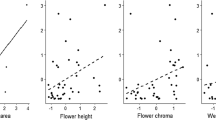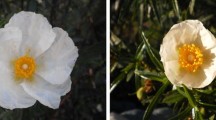Abstract
Plant traits that increase pollinator visitation should be under strong selection. However, few studies have demonstrated a causal link between natural variation in attractive traits and natural variation in visitation to whole plants. Here we examine the effects of flower number and size on visitation to wild radish by two taxa of pollinators over 3 years, using a combination of multiple regression and experimental reductions in both traits. We found strong, consistent evidence that increases in both flower number and size cause increased visitation by syrphid flies. The results for small bees were harder to interpret, because the multiple regression and experimental manipulation results did not agree. It is likely that increased flower size causes a weak increase in small-bee visitation, but strong relationships between flower number and small-bee visitation seen in 2 years of observational studies were not corroborated by experimental manipulation of this trait. Small bees may actually have responded to an unmeasured trait correlated with flower number, or lower small-bee abundances when the flower number manipulation was conducted may have reduced our ability to detect a causal relationship. We conclude that studies using only 1 year, one method, or measuring only one trait may not provide an adequate understanding of the effects of plant traits on pollinator attraction.
Similar content being viewed by others
References
Augspurger CK (1980) Mass-flowering of a tropical shrub (Hybanthus prunifolius): influence on pollinator attraction and movement. Evolution 34:475–488
Bell G (1985) On the function of flowers. Proc R Soc Lond B 224:223–265
Buchmann SL, Cane JH (1989) Bees assess pollen returns while sonicating Solanum flowers. Oecologia 81:289–294
Campbell DR, Waser NM, Price MV, Lynch EA, Mitchell RJ (1991) Components of phenotypic selection: pollen export and flower corolla width in Ipomopsis aggregata. Evolution 45:1458–1467
Clements FE, Long FL (1923) Experimental pollination: an outline of the ecology of flowers and insects. Carnegie Institution of Washington, Washington, DC
Conner J, Via S (1993) Patterns of phenotypic and genetic correlations among morphological and life-history traits in wild radish, Raphanus raphanistrum. Evolution 47:704–711
Conner JK, Davis R, Rush S (1995) The effect of wild radish floral morphology on pollination efficiency by four taxa of pollinators. Oecologia 104:234–245
Conner JK, Rush S, Jennetten P (1996) Measurements of natural selection on floral traits in wild radish (Raphanus raphanistrum). I. Selection through lifetime female fitness. Evolution, in press
Cruzan MB, Neal PR, Willson MF (1988) Floral display in Phyla incisa: consequences for male and female reproductive success. Evolution 42:505–515
Darwin C (1877) The different forms of flowers on plants of the same species. University of Chicago Press, Chicago
Eckhart VM (1991) The effects of floral display on pollinator visitation vary among populations of Phacelia linearis (Hydrophyllaceae). Evol Ecol 5:370–384
Eckhart VM (1992) Spatio-temporal variation in abundance and variation in foraging behavior of the pollinators of gynodioecious Phacelia linearis (Hydrophyllaceae). Oikos 64:573–586
Galen C (1989) Measuring pollinator-mediated selection on morphometric traits: bumblebees and the alpine sky pilot, Polemonium viscosum. Evolution 43:882–890
Galen C, Newport MEA (1987) Bumble bee behavior and selection on flower size in the sky pilot, Polemonium viscosum. Oecologia 74:20–23
Geber MA (1985) The relationship of plant size to self-pollination in Mertensia ciliata. Ecology 66:762–772
Harder LD, Thomson JD, Cruzan MB, Unnasch RS (1985) Sexual reproduction and variation in floral morphology in an ephemeral vernal lily, Erythronium americanum. Oecologia 67:286–291
Hodges CM, Miller RB (1981) Pollinator flight directionality and the assessment of pollen returns. Oecologia 50:376–379
Kay QON (1976) Preferential pollination of yellow-flowered morphs of Raphanus raphanistrum by Pieris and Eristalis spp. Nature 261:230–232
Kearns CA, Inouye DW (1993) Techniques for pollination biologists. University Press of Colorado, Niwot
Lande R, Arnold SJ (1983) The measurement of selection on correlated characters. Evolution 37:1210–1226
Mitchell RJ (1993) Path analysis: pollination. In: Scheiner SM, Gurevitch J (eds) Design and analysis of ecological experiments. Chapman and Hall, New York, pp 211–231
Neter J, Wasserman W, Kutner MH (1985) Applied linear statistical models, 2nd edn. Irwin, Homewood
Rush S, Conner J, Jennetten P (1995) The effects of natural variation in pollinator visitation on rates of pollen removal in wild radish, Raphanus raphanistrum (Brassicaceae). Am J Bot 82:1522–1526
Sampson DR (1964) A one-locus self-incompatibility system in Raphanus raphanistrum. Can J Genet Cytol 6:435–445
SAS Institute (1994) JMP, version 3. SAS Institute, Cary
Schmid-Hempel P, Speiser B (1988) Effects of inflorescence size on pollination in Epilobium angustifolium. Oikos 53:98–104
Stanton ML, Preston RE (1988) Ecological consequences and phenotypic correlates of petal size variation in wild radish, Raphanus sativus (Brassicaceae) Am J Bot 75:528–539
Stanton ML, Snow AA, Handel SN (1986) Floral evolution: attractiveness to pollinators increases male fitness. Science 232:1625–1627
Stanton ML, Snow AA, Handel SN, Bereczky J (1989) The impact of a flower-color polymorphism on mating patterns in experimental populations of wild radish (Raphanus raphanistrum L.). Evolution 43:335–346
Stanton ML, Young HJ, Ellstrand NC, Clegg JM (1991) Consequences of floral variation for male and female reproduction in experimental populations of wild radish, Raphanus sativus L. Evolution 45:268–280
Thomson JD (1988) Effects of variation in inflorescence size and floral rewards on the visitation rates of traplining pollinators of Aralia hispida. Evol Ecol 2:65–76
Thomson JD, Maddison WP, Plowright RC (1982) Behavior of bumble bee pollinators of Aralia hispida Vent. (Araliaceae). Oecologia 54:326–336
Waser NM (1983) The adaptive nature of floral traits: ideas and evidence. In: Real L (eds) Pollination biology. Academic Press, Orlando, pp 241–285
Willson MF, Bertin RI (1979) Flower-visitors, nectar production, and inflorescence size of Asclepias syriaca. Can J Bot 57:1380–1388
Willson MF, Rathcke BJ (1974) Adaptive design of the floral display in Asclepias syriaca L. Am Midl Nat 92:47–57
Young HJ, Stanton ML (1990) Influences of floral variation on pollen removal and seed production in wild radish. Ecology 71:536–547
Author information
Authors and Affiliations
Rights and permissions
About this article
Cite this article
Conner, J.K., Rush, S. Effects of flower size and number on pollinator visitation to wild radish, Raphanus raphanistrum . Oecologia 105, 509–516 (1996). https://doi.org/10.1007/BF00330014
Received:
Accepted:
Issue Date:
DOI: https://doi.org/10.1007/BF00330014




